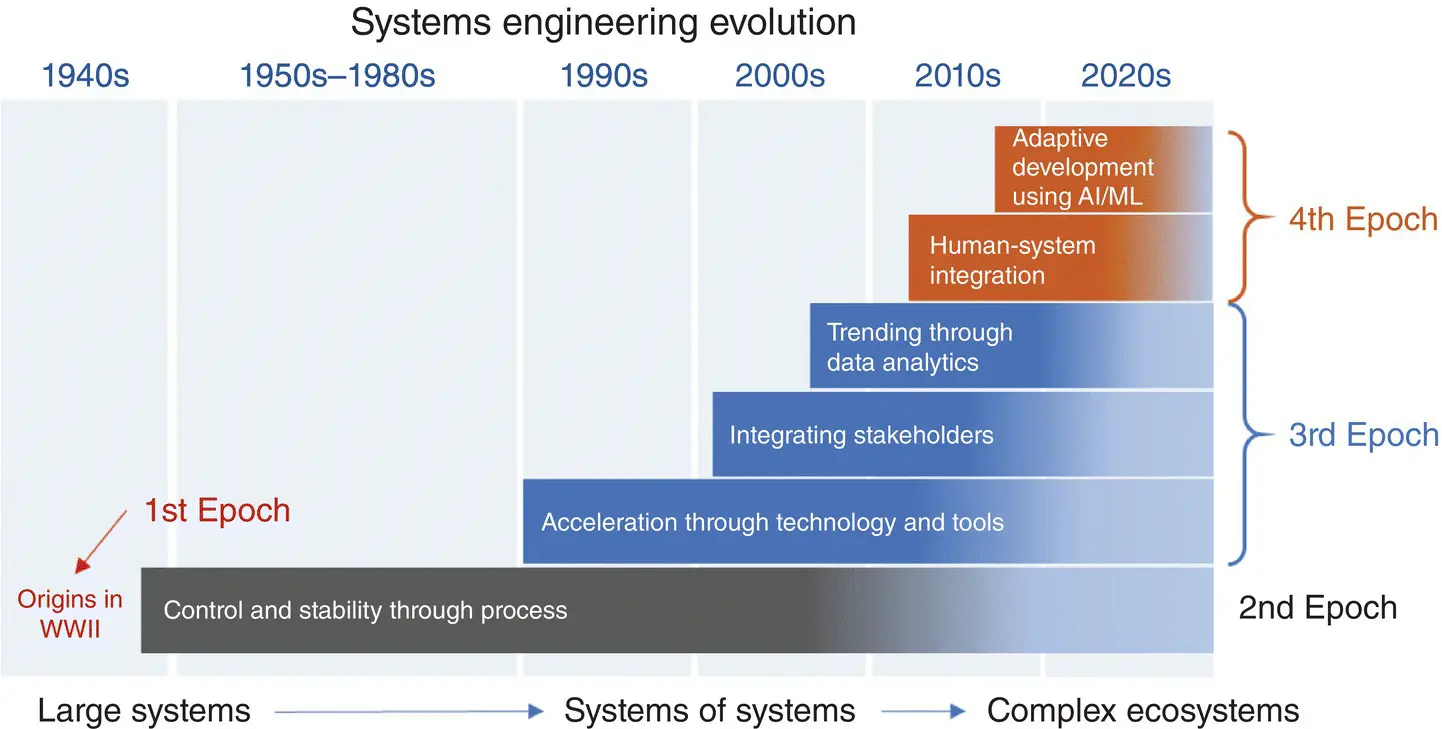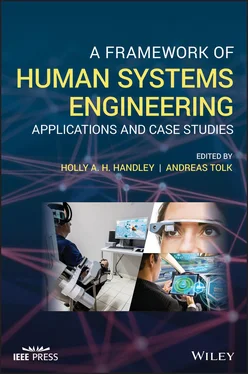A Framework of Human Systems Engineering
Здесь есть возможность читать онлайн «A Framework of Human Systems Engineering» — ознакомительный отрывок электронной книги совершенно бесплатно, а после прочтения отрывка купить полную версию. В некоторых случаях можно слушать аудио, скачать через торрент в формате fb2 и присутствует краткое содержание. Жанр: unrecognised, на английском языке. Описание произведения, (предисловие) а так же отзывы посетителей доступны на портале библиотеки ЛибКат.
- Название:A Framework of Human Systems Engineering
- Автор:
- Жанр:
- Год:неизвестен
- ISBN:нет данных
- Рейтинг книги:4 / 5. Голосов: 1
-
Избранное:Добавить в избранное
- Отзывы:
-
Ваша оценка:
- 80
- 1
- 2
- 3
- 4
- 5
A Framework of Human Systems Engineering: краткое содержание, описание и аннотация
Предлагаем к чтению аннотацию, описание, краткое содержание или предисловие (зависит от того, что написал сам автор книги «A Framework of Human Systems Engineering»). Если вы не нашли необходимую информацию о книге — напишите в комментариях, мы постараемся отыскать её.
A Framework of Human Systems Engineering
Applications and Case Studies
A Framework of Human Systems Engineering: Applications and Case Studies
A Framework of Human Systems Engineering — читать онлайн ознакомительный отрывок
Ниже представлен текст книги, разбитый по страницам. Система сохранения места последней прочитанной страницы, позволяет с удобством читать онлайн бесплатно книгу «A Framework of Human Systems Engineering», без необходимости каждый раз заново искать на чём Вы остановились. Поставьте закладку, и сможете в любой момент перейти на страницу, на которой закончили чтение.
Интервал:
Закладка:
2.6 Human Interface Considerations for Privacy‐Aware SA
The ability for HSI systems to understand the complex data used to achieve SA, as well as the context of the human operator consuming the information, will reach its apex in the form of minimum viable data presentation. Demands for better protection of PII have evolved over the past decade to include right to PII data ownership and demands on disclosure of PII use and storage. These rights have been codified through legislation including the European Union's General Data Protection Regulation (GDPR), 7 California Consumer Privacy Act (CCPA), 8 and Illinois Biometric Information Privacy Act (BIPA). 9 Though most legislation currently allows for lawful government use, the expectation is that government will adhere to the underlying principles in the performance of its duty.
To illustrate the impact such privacy‐aware requirements have on SA platforms, consider the example of electronic identification (eID) mechanisms such as the mobile driver's license (mDL). Visitors to secure facilities, individuals involved in routine traffic stops, and even patrons to bars have historically been required to present a government‐issued document verifying their name, date of birth, and other PII. Such credentials often violate the principle of minimum viable data as only portions of this information or, more precisely, derivatives of this information are needed to affect the requisite vetting. The root question of the individual accessing the secure facility is whether he or she is authorized to access the site, just as the bouncer is fundamentally concerned with whether or not the individual is of legal age to enter the bar. All other PII contained on the credential is incidental to this core concern and represents an elevated risk to the SA operator – providing them the opportunity to act on information irrelevant to the interaction – and to the information provider by disclosing more PII than necessary to complete the transaction. To mitigate these risks, the Secure Technology Alliance has advocated the widespread adoption of eIDs such as mDLs. 10 Such solutions provide the operator the pertinent derivative information – whether or not the person is of legal age – without disclosing the underlying PII (name, date of birth, address, etc.). Such solutions not only have the potential to improve the efficiency of SA operations but also mitigate the risk of excess PII disclosure.
Another manifestation of the requirement of SA platforms to incorporate privacy‐aware concepts in their design and operation comes in the form of demands for greater transparency and auditability. Regulators and privacy advocates are increasingly interested in the means by which public safety organizations achieve SA, concerning themselves not only with the underlying data employed but also with the tools used to analyze and correlate aggregate data sources. Interest in this tooling is only increasing with the proliferation of AI as the determination of relevance and scoring of risk shifts from human operators to machines. The debate around facial recognition epitomizes this concern, as highlighted by Georgetown Law's “The Perpetual Lineup” report. 11
The impact such privacy‐aware demands will have on SA platforms is manifold. As minimal viable data presentation capabilities progress, the data available to SA platforms will shift from primary source data to derivative data, and the need for contextualization and inference will increase. To overcome these and other challenges, SA platforms will increasingly incorporate AI to interpret information and ascertain relevance to the operator. As AI becomes increasingly pervasive, SA platforms must develop the capacity to explain nonhuman decision‐making processes and accommodate transparency and independent auditing.
The impact these changes will have on HSI concerns is equally complex. On one hand, the ability to develop and interpret derivative information will improve the efficiency of man–machine interfaces by focusing operators on the most pertinent information available. On the other, the use of AI and reliance on derivative datasets will increase the demand on auditors tasked with ensuring the SA platform is making reasoned decisions, without bias, and that traceability is maintained to primary data where appropriate.
Reference
1 Endsley, M.R. (2011). Designing for Situation Awareness. Boca Raton, FL: CRC Press, Inc.
Notes
1 1 https://www.researchgate.net/publication/285745823_A_model_of_inter_and_intra_team_situation_awareness_ Implications_for_design_training_and_measurement_New_trends_in_cooperative_activities_Understanding_system_dynamics_in_complex_environments.
2 2https://www1.nyc.gov/site/nypd/about/about‐nypd/equipment‐tech/technology.page.
3 3 https://asia.nikkei.com/Business/China‐tech/China‐s‐sharp‐eyes‐offer‐chance‐to‐take‐surveillance‐ industry‐global.
4 4 https://www.prnewswire.com/news‐releases/the‐global‐video‐surveillance‐market‐is‐expected‐to‐grow‐over‐ 77‐21‐billion‐by‐2023‐808999313.html.
5 5https://www.fbi.gov/file‐repository/cjis‐security‐policy‐v5_6_20170605.pdf.
6 6 https://doi.org/10.1145/3290605.3300768.
7 7 https://eur‐lex.europa.eu/eli/reg/2016/679/oj.
8 8 https://leginfo.legislature.ca.gov/faces/billTextClient.xhtml?bill_id=201720180AB375.
9 9 http://www.ilga.gov/legislation/ilcs/ilcs3.asp?ActID=3004&ChapterID=57.
10 10https://www.securetechalliance.org/mobile‐drivers‐license‐initiative.
11 11 www.perpetuallineup.org.
3 Utilizing Artificial Intelligence to Make Systems Engineering More Human *
Philip S. Barry1 and Steve Doskey2
1 George Mason University, Fairfax, VA, USA
2 The MITRE Corporation, McLean, VA, USA
3.1 Introduction
Systems engineering (SE) can be broken into several major phases since its inception during World War II. These major phases can be binned into four epochs, where each ensuing epoch builds on the knowledge and insights of the previous epochs as shown in Figure 3.1.

Figure 3.1 Systems engineering evolution.
Epoch 1 began with the origins of SE being driven by the advent of large systems being developed such as the telephone system and operations research concepts employed during World War II. Epoch 2 picked up in the mid‐1940s as Bell Labs (Fagen, 1978), DoD, and universities begin to formalize engineering development processes. While great strides were made, SE remained a methodology to maintain control and enforce stability in large programs. Epoch 3 changed SE by introducing technology as a force multiplier allowing industry to build ever more powerful SE tools that extended and leveraged the traditional processes developed in Epoch 2.
SE is now entering Epoch 4 that will integrate artificial intelligence (AI) and sociotechnical integration into the development and deployment of systems and systems of systems. AI has permeated our society in such diverse areas: improving mobile phone reception, spam filters, ride‐sharing apps, autopilot systems, and fighting fraud. Epoch 4 will integrate AI, not only in the deployed systems, but change how we engineer these systems as part of human systems engineering (HSE). Furthermore, AI coupled with advances in sociotechnical system design will change SE tools and methods used to develop systems.
There is increasing recognition of the importance of considering stakeholders as part of the system development ecosystem. Epoch 4 explicitly recognizes the “human” as a part of the system and requires development environments to take into consideration human behavior and humans’ proclivity for making choices not aligned with traditional statistical optimization. As the development of system capabilities evolve, it is apparent that a static interpretation of human integration into the system is insufficient. AI will enable real‐time interpretation of continuous human integration and will be interdependent, collaborative, and cooperate between people and systems (Kevin Reilly, 2020). To both identify existing risks and project into the future, AI‐based models mimicking human behavior and learning will be necessary, as part of the development ecosystem. As HSE matures, these models will be a common component of HSE to design and build highly adaptive and resilient systems needed to keep pace with the velocity of change in business. This chapter presents a framework for defining and identifying the elements for the next evolution of SE, Epoch 4.
Читать дальшеИнтервал:
Закладка:
Похожие книги на «A Framework of Human Systems Engineering»
Представляем Вашему вниманию похожие книги на «A Framework of Human Systems Engineering» списком для выбора. Мы отобрали схожую по названию и смыслу литературу в надежде предоставить читателям больше вариантов отыскать новые, интересные, ещё непрочитанные произведения.
Обсуждение, отзывы о книге «A Framework of Human Systems Engineering» и просто собственные мнения читателей. Оставьте ваши комментарии, напишите, что Вы думаете о произведении, его смысле или главных героях. Укажите что конкретно понравилось, а что нет, и почему Вы так считаете.












